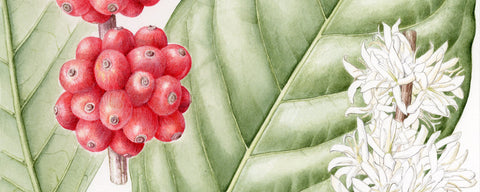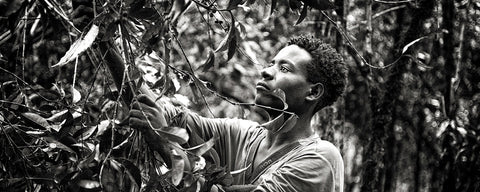First Published - April 6, 2018 (By Rudy – Cupping Guru)
Passion and forward-thinking
Bright Note was created by our founders Steven and Jeremy back in 2002. They wanted to create a blend that showcased the natural characteristics of coffee and introduce coffee drinkers to a lighter and brighter roast profile, whilst remaining accessible. They decided on three different components: a Brazil Natural, a Brazil Washed and a Guatemala Washed – the former would bring depth, chocolate and nut notes whilst the latter would brighten up the cup with a soft citric acidity. The Brazil washed would link the two together creating synergy. Our delicious Bright Note was born!
Now a fair few years down the line, we realise that the speciality coffee industry has come a long way and considerably evolved over time, and so has its customer base. What was bright back then is quite different from what people deem bright by today’s standards, and the expertise of modern baristas has considerably raised the bar of what is achievable in coffee shops. These elements together have pushed us to re-think the recipe of Bright Note, staying true to its original purpose.
New recipe, new opportunities:
We wanted to make the blend brighter and flavourful, to work both as espresso and with milk, to be easy to work with and remain a crowd-pleaser. Trying to tick all the boxes hey?
Breaking this down, we cupped to find a bright and vibrant coffee that would bring sweetness and liveliness to the cup, and a syrupy and chocolatey coffee that would bring depth and balance. Finding the right components that have the perfect synergy is in itself quite complex but in addition, we also wanted to take this opportunity to make a positive change and work with origins that need more support.
The components:
We were looking specifically for 2 washed coffees because this post-harvest process produces coffees with high acidity and clarity of flavour. We started by short-listing several lots from different countries and after a fair few experiments we found what we were looking for in two countries: Colombia and Brazil.
Timana, Colombia
Cooperative: Asprotimana
Region: Timana, Huila
Altitude: 1500 masL
Variety: Caturra, Colombia, Castillo
Process: Washed
Centuries ago, a warrior tribe ruled the land this coffee grows on. This coffee is named after them – Timana. Back in 2001, a community of 32 smallholder farmers decided to work together to improve processing methods and by extension the quality of their coffee in order to gain better access to the market. They created a cooperative called ASociación de PRoductores agrícolas de Timaná – Asprotimana.
Timaná is a municipality located in the south of Huila, about a 180 km away from Neiva. Surrounded by the Central and Cordillera Central and Occidental ranges, the area has good soils and high altitude. The farmers are trained in good agricultural practices; these practices do not only contribute to environmental sustainability, but also to productivity and quality. Which makes this cooperative an excellent partner for growing high-quality Colombian coffee. With the goals to locally promote specialty coffee and create employment for young people they decided to build a lovely coffee shop at the heart of the village.
The lot we selected has a vibrant acidity with notes of blood orange, brown sugar and a caramel sweetness.
Primavera, Brazil
Producer: Ricardo Tavares
Region: Chapada de Minas, Minas Gerais
Altitude: 1000 masL
Variety: Catuai
Process: Washed
Primavera means “spring”, referring to the perfect climate to grow coffee on the farm, with average temperatures between 20 and 24 °C annually and precipitation of 1,000 to 1,300 mm. It is situated in the municipality of Angelândia, Minas Gerais (Chapada de Minas).
Following his father’s footsteps, producer Ricardo Tavares has dedicated his life to the coffee industry. He is an innovator and forward-thinker – he promotes and supports new coffee practices and as such has developed state-of-the-art installations including a 24,000 m² drying patio and some modern equipment to process fully washed coffees. He has also begun to introduce new cultivars such as Mundo Novo amongst his predominant red and yellow Catuai (currently 95% of the plantation).
The coffee we chose from his farm is very sweet and clean, with a soft citric acidity upfront and notes of milk chocolate, caramel and roasted nuts.
New blending process- Post-roast blend
To experience the unique individual characteristics of each component we decided to roast each coffee separately, blending them post-roast.
The result is a beautifully bright well balanced espresso with tangerine notes upfront and finishing with notes of chocolate and macadamia. With milk, expect gentle notes of pecan mellows into vanilla and custard cream finishing with notes of buttery shortbread and milk chocolate.







